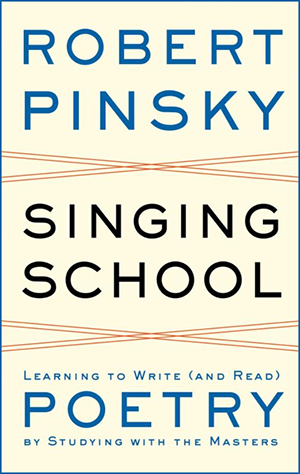
Robert Pinsky’s book might not teach anyone to write (or read) poetry, but it presents an intriguing collection of poems. Pinsky includes one of greatest cat poems ever written, “Jubilate Agno” by Christopher Smart featuring his cat, Jeoffrey. These collections of poetry try to cover all the bases. Plenty of variety, plenty of different styles. After reading Frank O’Hara’s “Why I Am Not a Painter” I want to read more of his poems. Pinsky provides some interesting information on the poets and their poems. If you’re in the mood for an entertaining collection of poetry, Singing School is it. How many of these poets are you familiar with? GRADE: B+
TABLE OF CONTENTS
Preface
I. FREEDOM
Introduction
FRANK O’HARA, “Why I Am Not a Painter”
Michaelangelo, “On Painting the Sistine Chapel Ceiling”
MARIANNE MOORE, “Silence”
ANONYMOUS, “The Old Cloak”
GREGORY CORSO, “Marriage”
EMILY DICKINSON, “Because I Could Not Stop for Death”
STEVIE SMITH, “Thoughts About the Person from Porlock”
WILLIAM CARLOS WILLIAMS, “Fine Work with Pitch and Cooper”
KENNETH KOCH, “Variations on a Theme by William Carlos Williams”
ALAN DUGAN, “How We Heard the Name”
JAMES SHIRLEY, “The Glories of Our Blood and State”
EDWARD THOMAS, “Adlestrop”
ANDREW MARVELL, “Upon Appleton House”
JONATHAN SWIFT, “A Description of the Morning”
APHRA BEHN, “The Disappointment”
GERARD MANLEY HOPKINS, “God’s Grandeur”
JOHN WILMOT, “Upon Nothing”
II. LISTENING
Introduction
WALTER SAVAGE LANDOR, “On Love, on Grief”
GEORGE PEELE, “Betsabe’s Song”
H.D., “The Pool”
EDWIN ARLINGTON ROBINSON, “Eros Turannos”
BEN JONSON, “His Excuse for Loving”
BEN JONSON, “My Picture Left in Scotland”
ROBERT HERRICK, “Upon M. Ben Johnson”
GERARD MANLEY HOPKINS, “For Margaret”
THOMAS CAMPION, “Now Winter Nights Enlarge”
THOM GUNN, “Tamer and Hawk”
MINA LOY, from “Songs to Joannes,” I-III
WILLIAM CARLOS WILLIAMS, “To Waken an Old Lady”
ROBERT FROST, “To Earthward”
ROBERT FROST, “An Old Man’s Winter Night”
WALTER RALEGH, “Nature, That Washed Her Hand in Milk”
WALLACE STEVENS, “The House Was Quiet and the World Was Calm”
WILLIAM BUTLER YEATS, “Adam’s Curse”
EMILY DICKINSON, “The Soul Selects Her Own Society”
III. FORM
Introduction
ANONYMOUS, “The Cruel Mother”
ANONYMOUS, “The Man of Double Deed”
CHIDIOCK TICHBORNE, “My Prime of Youth Is but a Frost of Cares”
SAPPHO, “Artfully Adorned Aphrodite”
WILLIAM CARLOS WILLIAMS, “To a Poor Old Woman”
THOMAS NASHE, “In Time of Plague”
H.D., “Sea Rose”
WILLAIM BLAKE, “A Question Answered”
CHRISTOPHER SMART, from “Jubilate Agno”
FULKE GREVILLE, “Elegy for Philip Sidney”
ALLEN GINSBERG, from “Howl” II
MAY SWENSON, “Question”
LANGSTON HUGHES, “The Negro Speaks of Rivers”
GEORGE GASCOIGNE, “The Lullaby of a Lover”
GEORGE HERBERT, “Church Monuments”
THOMAS HARDY, “During Wind and Rain”
IV. DREAMING THINGS UP
Introduction
ELIZABETH BISHOP, “The Weed”
GEORGE HERBERT, “Love Unknown”
ROBERT SOUTHWELL, “The Burning Babe”
THOMAS HARDY, “The Self-Unseeing”
JOHN CROWE RANSOM, “Captain Carpenter”
JORGE DE LIMA, “The Big Mystical Circus”
ROBERT HERRICK, “The Shooe Tying” and “To God, on His Sicknesse”
WALLACE STEVENS, “Madame La Fleurie”
WILLIAM COWPER, “Epitaph on a Hare”
LOUISE BOGAN, “Women”
STERLING BROWN, “Harlem Happiness”
ELIZABETH I, “When I Was Fair and Young”
WALT WHITMAN, “Vigil Strange I Kept on the Field One Night”
SYLVIA PLATH, “Nick and the Candlestick”
WILLIAM SHAKESPEARE, “The Phoenix and the Turtle”
BIBLE, Samuel 2, “David’s Lament for Saul and Jonathan”
LEWIS CARROLL, “Jabberwocky”
WILLIAM BUTLER YEATS, “The Lake Isle of Innisfree”
EZRA POUND, “The Lake Isle”
EZRA POUND, “The River-Merchant’s Wife: A Letter”
JOHN MILTON, “Methought I saw my late espoused saint”
WILLIAM BUTLER YEATS, from “A Woman Young and Old,” IV: “Her Triumph”
JOHN KEATS, “”Ode to a Nightingale”
MARIANNE MOORE, “Poetry”
JOHN KEATS, “On First Looking into Chapman’s Homer”
Biographies
Acknowledgements
Permissions
Index
I’ve read quite a few–my favorite being Wallace Stevens’s “The House Was Quiet and the World Was Calm,” which I first read in my teens. That poem informed my concept of the feeling a house should project–whether I have ever been successful in creating that atmosphere, I must leave for others to decide.
Deb, I’m a big Wallace Stevens fan, too. “The House Was Quiet and the World Was Calm” resonates with a lot of people. Great poem!
I could really use some advice in reading poems. LIke a lot of these but many are unfamiliar.
Patti, I suspect Pinsky was trying to include as many diverse poets as possible. Part of his mission is to get people to read unfamiliar poets. This books is a sampler.
Our own cat Jeoffrey as been gone for about 17 years now. Still miss the little rascal.
Bill, Jeoffrey is a great name for cat!
Those of you fond of Jubilate Agno, or cats named Jeoffrey, ought to know that Smart’s poem – or at least chunks of it – was set to music for chorus & organ by Benjamin Britten, as “Rejoice in the Lamb”. I’m not particularly keen on choral music, but I like this piece very much.
Art, I will certainly check out Benjamin Britten’s “Rejoice in the Lamb.” Sounds great!
Looks interesting. I’ve read maybe a third o f the poets offered, not always the specific work. I didn’t know “Rejoice in the Lamb” had that connection, but I have it and will give it a listen.
Rick, I have a couple recordings of “Rejoice in the Lamb” but haven’t had a chance to listen to them because I can’t find them! I need to get more organized.
I’m very familiar with Anonymous, who wrote thousands of poems on restroom stalls over the decades.
Bob, I’m more familiar with Anonymous who wrote all those sleazy novels.
The subject was poetry.